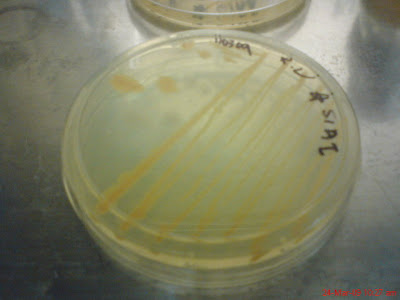After going through so much of antibiotic sensitivity experiment, clearly that S1AI is a bacteria that must be identified, as in finding out its name, species and etc. Other than that, 3 other unknown bacteria also been chosen to get identified. They are each labeled as K1AII, F and CC. CC is a kind of bacteria extracted from the plant. Thus, there are four bacteria that will be sent to sequencing in the end. The whole process of DNA extraction will usually takes about 3 hours. You do not have to run the whole process in laminar flow.
First day:
Material: sample of bacteria S1AI, K1AII, F and CC in plates, four 50ml conical flasks that filled with nutrient broth, inoculating loop, flame, parafilm, aluminium foil
Method:
1. Prepare cell suspension and shake it 24 hours in 37°C incubator at 13,000 rpm.
The next day:
Material: A lot of 1.5 eppendorf tubes, 50 mg/ml EDTA solution, 100mg/ml lysozyme solution, isopropranol solution, ice and ice box, DNA extraction kit, 1.5 eppendorf incubator, centrifuge machine, 10-20 ml of 70% ethanol, tips, 10 ul pipette, empty container.
PS: The EDTA solution, lysozyme and ispropanol solution must be put in the ice in the icebox at all times to prevent the stock from getting damaged.
Method for marine bacteria DNA extraction:
1. Put 5ul of overnight culture into 1.5 eppendorf tube and each labeled as CC, F, K1AII and
S1AI.
2. Close the cap and spinned in centrifuge machine at 13,000 rpm to 16,000 rpm for 3
mintues.
3. Take it out and discard the supernatant. Supernatant is the liquid that left after spinned. Make sure that the cells that stays at the bottom is not discarded!
4. Repeat step 1 - 3 until a clear big collection of cells at the bottom of the tube can be seen. DO NOT repeat the step more than 4 times.
5. Add 480ul of 50 mg/ml EDTA solution into the tubes by using the pipette and resuspend it with the cells that stays at the bottom.
6. Change tip of the pipette and add 120ul of lysozyme and pipette mix gently.
7. Incubate at 37°C with 1.5 eppendorf tube incubator for 1 hour.
8. After 1 hour, take out the tubes and centrifuge at 13,000-16,000 rpm for 3 minutes.
9. Remove supernatant again and collect the cells that stays at the bottom. (meaning leave it there)
10. Add 600ul of nucleic lysis solution from the DNA Extraction kit and pipette mix gently.
11. Close the tube and incubate using the eppendorf machine at 80°C for 5 minutes. The purpose of this step is to lyse cells.
12. Cool the tubes to room temperature.
13. Add 3ul of RNase solution from the DNA Extraction kit and mix by invert tube (with the cap closed) for 2-5 minutes and incubate at 37°C for 1 hour.
14. Cool to room temperature.
15. Add 200ul of protein Precipitation solution and spin at high speed within 13,000rpm with centrifuge machine at 1 minute.
16. Incubate on ice for 5 minutes. (you can put it in the icebox where the isopropanol solution and others are stored.
17. Take the tubes out and centrifuge at 13,000-16,000rpm for 3 minutes with centrifuge machine.
18. Prepare empty 1.5 eppendorf tubes with 600ul isoproponol solution for each sample. Pour the supernatant from the old tubes that just took out from the centrifuge machine into this new tube and mix by inversion of tube. (with cap closed)
19. After mixing, put the tubes to centrifuge at 13,000 -16,000 rpm for 3 minutes.
20. Pour the supernatant and drain the tube by invert with clean absorbent paper.
21. After draining, add 600ul of ethanol and centrifuge at 13,000-16,000rpm with centrifuge machine for 3 minutes.
22. Aspirate the ethanol and drain on clean absorbent paper for 15 minutes.
23. Redesolve the cells that stays at the bottom of the tube with DNA rehydration solution, and keep in -21°C fridge.
The centrifuge machine. The amount of tubes that been put into the machine must be even number and the position of it in the machine must be opposite each other to balance up during spinning.
The next process is to run Gel Electrophoresis to find out if there is any DNA been extracted during this process of not.
Monday, April 13, 2009
March 27- DNA Extraction
Posted by SunSeT at 2:46 PM
Subscribe to:
Post Comments (Atom)







0 comments:
Post a Comment